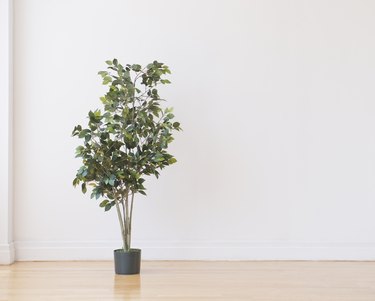
There are about 850 ficus species in the plants' genus, all belonging to the Moraceae family. However, the weeping fig (Ficus benjamina, USDA hardiness zone 10 to 12 if grown outside) is what most people refer to when speaking of a ficus. Its green, shiny, mid-sized leaves are dense, and the benjamina also offers a variegated-leaf variety. From college dorms to sophisticated living rooms, the Ficus benjamina adds life to a room, is easy to care for and for a decorative touch, you can braid the trunks of the ficus, creating an exotic visual. Best kept as an indoor plant, Ficus benjamina suffers from only a few pests, but the white spots on the ficus leaves are usually a good thing.
Recognizing the Different White Spots
Video of the Day
Plants store energy through photosynthesis, converting light into energy, promoting growth. Occasionally little white specks appear on the upper portion of the leaf, close to the vein. These are known as cystoliths, and are actually calcium carbonate crystals. They aid in photosynthesis by scattering light throughout the leaf. Because the ficus's leaves contain all three minerals necessary for extended life, the plant can survive in a multitude of climates, from rainforests to clifftops, aided by cystoliths. Do not brush or pick them off the leaves.
Video of the Day
A messier problem affecting ficus benjamina is powdery mildew. It starts out as white spots, but over time morphs into white patches that cover a majority of the upper side of the leaves. Indoor plants aren't as susceptible to this disease as outdoor varieties because the spores are carried by the wind throughout the garden. However, if you find powdery mildew on your ficus leaves, spray them with neem oil, or mix 1 teaspoon of baking soda with a quart of water and spray thoroughly.
Ficus Insect Infestation
Mealy bugs, those small, pale insects burrowing on the underside of your ficus leaves and where the leaf attaches itself to the stem are at war with your plant – and they usually win. They move very slowly and cover themselves and their eggs with a white material that looks like cotton. They suck ficus sap, disfiguring the plant and often causing its death. Their waxy coat makes them impervious to insecticides.
A cotton swab dipped in alcohol and placed on top of the bug often kills it, as does a forceful stream of water, but this usually just reduces the mealybug population instead of eliminating it. You must separate the ficus from your other plants, examine all nearby plants and try to identify the source of the infestation. A more drastic measure is to destroy the plant altogether. Do not place it in a compost pile or where the bugs can travel.
Getting Rid of Scale
While scales, a hardy insect with either an armored hard shell or a flat soft covering, don't leave white spots on a ficus, they do severe damage to a plant. Appearing as brown bumps, scales produce a sticky substance known as honeydew, which is the first indicator of an infestation. Black, sooty mold grows on the honeydew, compounding the problem. Insecticidal soap works to eliminate young scales, and alcohol swabs are effective against adults. Separate an infected ficus from other plants immediately.
Preventing plant infestation that can permanently damage your ficus starts with introducing your houseplant slowly to the environment. Garden centers are often the originators of plant disease, and you don't want to bring them home with you. If you bring your ficus outdoors, introduce ladybugs as a form of insect control. They are especially effective against scales.
.
- Leafy Place: Types of Ficus Trees: Outdoors and Indoors Ficus Plants
- Green Experiment Company: What Are The White Spots on My Rubber Plant?
- U.S. National Library of Medicine: Mineral Deposits in Ficus Leaves
- University of California Master Gardener Program of Contra Costa County: Ficua Benjamina vs. Mealybugs